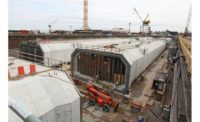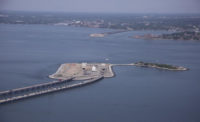Virginia Bridge-Tunnel Expansion Progresses Toward Next Major Milestone

One year into its scheduled 55-month construction schedule, the $3.8 billion Hampton Roads Bridge-Tunnel Expansion project is making significant progress toward the planned mid-2022 start of boring for twin two-lane 7,500-ft-long tubes, doubling the existing crossing’s capacity.
According to Virginia Dept. of Transportation project director Jim Utterback, about 505,000 sq ft of slurry wall panels have been completed on the existing south portal island to support excavation for the tunnel boring machine’s 65-ft-deep launch pit. Hampton Roads Connector Partners (HRCP)—a design-build joint venture of Dragados USA, Vinci, Dodin Campenon Bernard and Flatiron Constructors—is now redeploying the slurry equipment to the north portal island, which was recently expanded by approximately 15 acres.
Meanwhile, HRCP has driven more than a quarter of about 1,000 54-in-diameter concrete cylinder pilings for 14,000 ft of new trestle bridges.
“Precast pile caps will also be used to ensure a 100-year service life, and eliminate the challenges of doing cast-in-place over water,” Utterback says.
When complete, the trestle bridge decks will be up to 8 ft higher than the existing parallel structures, a nod to climate change, resiliency and long-term maintenance for the crossing, which already handles 100,000 vehicles a day and serves as an emergency evacuation route for one of Virginia’s most populous regions.
“Even now during storms, waves crash against the existing structure and occasionally overtops it,” Utterback says.
Several landside bridge upgrades within the 9.9-mile project corridor are also underway. Existing structures on both the Hampton and Norfolk sides of Hampton Roads will be widened to integrate expanded tunnel crossing into adjacent surface traffic networks.
The expansion project's tunnel boring machine is expected to arrive at the project site in November. Built over 14 months by Herrenknecht of Germany, it is named for the late Mary Winston Jackson, a pioneering Black NASA aeronautical engineer depicted in the movie “Hidden Figures,” and is the largest variable density TBM built to date.
“That will be a big help in dealing with any difficult soils,” Utterback says.
Once reassembled, tested and readied to begin work, the TBM will drill the new 45-ft-diameter tubes approximately 50 ft deeper than the existing 7,500-ft long immersed steel tunnels, which were built in 1957 and 1976. The tunnel interior will be fitted with 21,000 concrete liner segments.
While the entire project is set for completion in 2025, tunneling is central to the critical path. “Right now, it’s all about getting the launch and receiving shafts done so we can get started by the third quarter of next year,” Utterback says.
Another project concern, protecting the trestles and tunnels against the effects of the marine environment’s corrosive effects, has been complicated by material availability issues. Utterback says the design-build team’s engineers have been developing separate plans and specifications for both CFRP and stainless steel reinforcement components.





